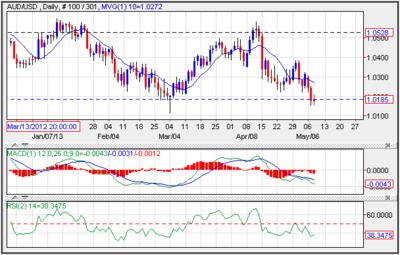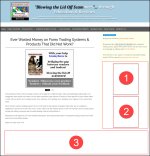- Home
- Forex Articles
- Forex Trading
- The Aussie Dollar is on the Ropes 13 May 2013
The Aussie Dollar is on the Ropes 13 May 2013
by forexbonus.co.uk

AUD/USD Daily Chart May 2013
The Australian dollar is facing defensive trading pressure on the heels of the recent reduction in their overnight lending rate. The combination of softer than expected economic data from Australia has led the central bank down a path that could see a further easing to its benchmark lending rate.
Economic data has been relatively tame down under and last week soft inflation report assisted the RBA in making its decision. Prior to meeting on May 7th, 2013, expectations of a decline in rates were approximately 30% which explain the quick move lower for the AUD/USD currency pair.
The Reserve Bank of Australia's 25 basis point interest rate cut saw numerous banks pass on the reduction into mortgage rates as well as deposit rates. The goal is to stimulate the Australian economy by increasing lending, as well as discouraging individuals from depositing capital into banks and to stimulate investors to look toward riskier assets. The RBA cited soft credit demand and the softer global economic data behind the decision. The central bank in its statement made it clear that additional measures could be coming soon which could include additional cuts from the current 2.75% rate.
This Thursday, May 9, 2013, the Australian Bureau of Statistics will release data on the current employment situation. The average forecast is for the unemployment rate to have remained flat at 5.6 per cent in April, with total employment growing by 11K jobs. Part of the rate is the participation rate, which measures the percentage of the people either employed or looking for a job is expected to remain flat. The issue with a declining labor participation rate is that the unemployment rate could continue to fall generating a misleading number as participation falls.
Another factor that could continue to erode the value of the AUD/USD is soft Chinese data. The weaker than expected PMI data release last week was somewhat offset by a better than expected trade surplus. The April trade surplus printed at $18.16 billion which was better than expected given the deficit reported in March. Exports rose 14.7% year over year after a 10% increase in March, while analysts expected about a 9.2% increase. Imports rose 16.8% on a year over year basis.
Technically, the Australian dollar is likely to test the recent March lows near 1.01. A break of this level, which coincides with weekly support levels, is likely to lead to target support near .9850. Resistance on the currency pair is seen near the 10-day moving average at 1.0275.
Momentum on the AUD/USD is moving further toward negative levels. Although the MACD did not generate a sell signal in late April, the index moved from a slight negative to a higher negative reflecting negative sentiment. The RSI (relative strength index) which is an oscillator that measures overbought and oversold levels is printing near 38, which is on the low end of the neutral range but well above the oversold trigger level of 30.
(Chart courtesy of Intertrader who are currently offering a £/$5000. Sorry website no longer active.





